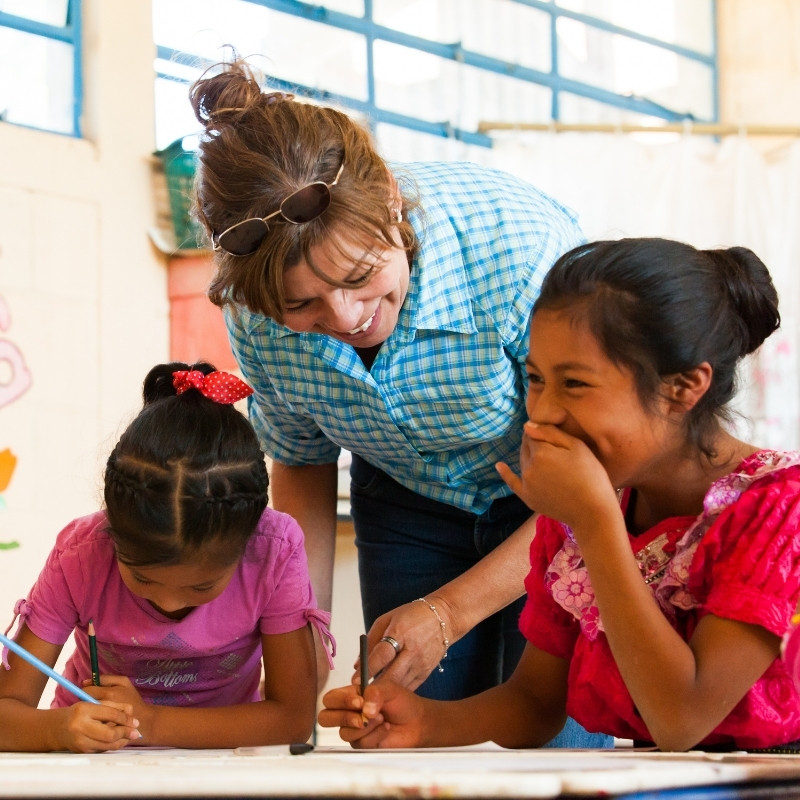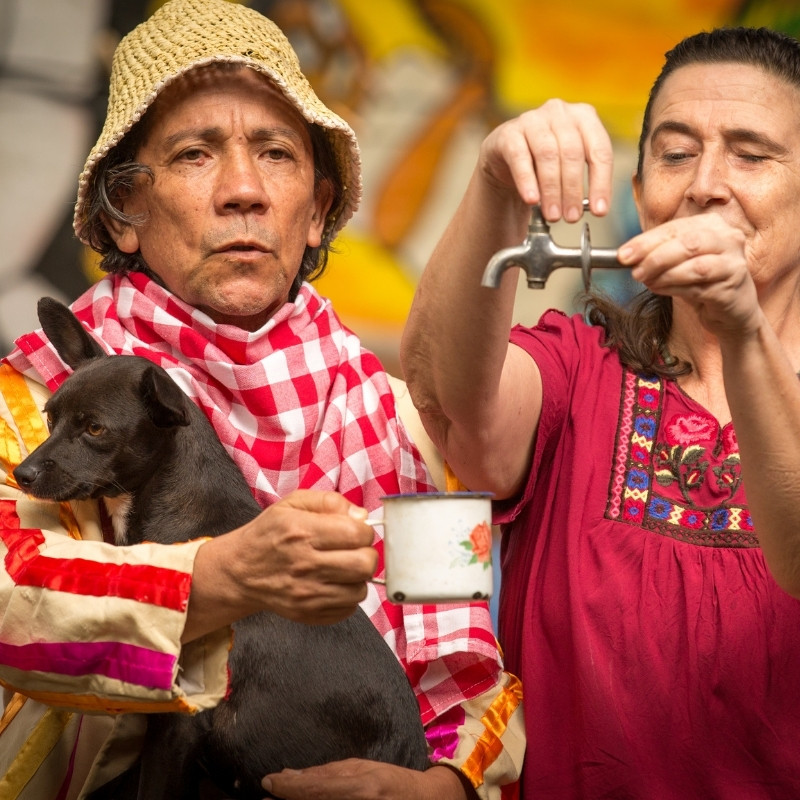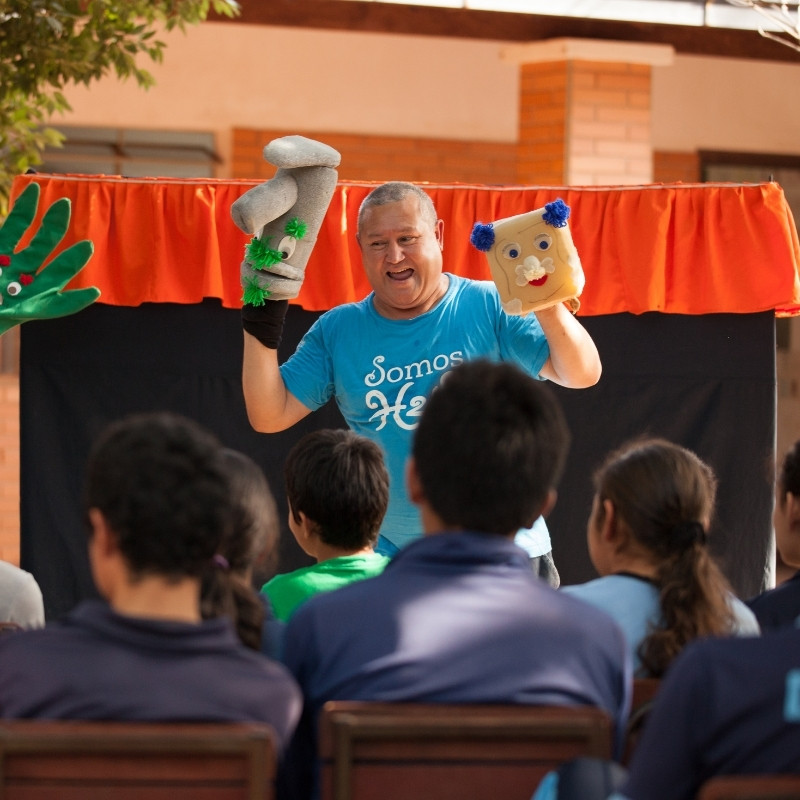The 3 components of our Model A·B·C for SustainabilityTM
from One Drop Foundation, applied to Lazos de Agua Program.

Our A·B·C for SustainabilityTM Model proposes a perspective that intentionally requires adaptability with each project considering the context of each country, the work model of each implementing partner, and the local population of the communities.
As a result, each of the 5 countries that conform the Program, share the same components but implemented in different ways in each country.
This is the key of our work. Water sustainability.

Access or improvement of infrastructure
The A Component consists of improving access to water and sanitation services through infrastructure construction or renovation, as well as the strengthening of their operators, community organizations, or other institutions involved in the provision of Water, Sanitation and/or Hygiene (WASH) services.
As of December 2022
More than
have obtained sustainable access to water, sanitation and/or hygiene (WASH).
More than
from rural and peri-urban areas in Colombia, Guatemala, Mexico, Nicaragua, and Paraguay were benefited.








Despite the challenges brought on by the pandemic, these results were possible thanks to the collaboration between:
Communities
Governments
Social Artists
Local Value Chain Actors
Project Implementers
Program Founding Partners
Behaviour change
The B Component is developed through One Drop Foundation's Social Art for Behaviour Change™ (SABC) approach that encourages the adoption of key behaviors around WASH.
SABC activities are based on scientific evidence, and take into account contextual, psychosocial and technological determinants of behavior.
These activities, which involve participatory processes, are inspired by the local context, drawing on cultural and artistic references.
Inspire, Activate & Sustain
The Social Art for Behaviour Change™ (SABC) approach presents 3 pillars that empower communities to lead projects themselves and contribute to their sustainability.

Inspire
(They seek to inform the community, to lead them to question, and generate commitment regarding the adoption of healthier behaviuors around WASH.
During this stage it's possible to discover the community members who can be trained as Leaders of Change.
Example: theater-forum, in which participants interact with the artists).

Activate
(The Activate stage also seeks the barriers reduction or transformation that prevent the adoption of the desired behaviour, and the improvement of the motivators that promote the adoption of such behaviour.
Examples: puppets, social circus, theater and storytelling workshops, and processes with governments, teachers and water suppliers, among others.)

Sustain
(Best practices are also promoted within the priority groups and Leaders of Change; the Inspire and Activate interventions are reinforced; processes, results, and emerging knowledge that occurred during the interventions are documented.
Example: creation processes for short films, photonovelas, radio soap operas and video clips).

Do you want to know more about the origin of this approach?
The importance of
Leaders of Change
To encourage the adoption of healthy and sustainable practices related to WASH, it's essential to integrate existing community leaders and other community members throughout the process.
These people are trained within the Program framework and participate in various activities to consolidate themselves as Leaders of Change. This allows our implementations to generate an impact in the individual, interpersonal and community spheres at another level. Water sustainability.
The SABC approach invites the actors in the process to
think, learn, and act beyond the established.
This approach has its roots on popular knowledge, edutainment, social circus (in particular the Cirque du Monde initiative of Cirque du Soleil), social art, communication for social and behavioural change, and the science of behavioural change.
At Lazos de Agua, the SABC enhances and strengthens the practice
of fundamental behaviours such as:

Hand-washing with soap and water at critical moments

Safe treatment and storage of drinking water at home

Water fee payment and/or sewage service fee
SABC IN ACTION
What are
SABC activities?
These are activities that comprise a participatory creation process in which social art tools are produced which, as a whole, inspire and activate the adoption of desired behaviours, and contribute to the sustainability of their practices.
What are the
Participatory SABC Processes?
These are activities in which social artists, key actors, priority groups and influencers interact around creative, playful and didactic experiences that represent everyday situations and practices related to WASH.
SABC activities open up spaces for dialogue and debate that are key to generating joint solutions.
Learn the SABC basics
Explore the SABC approach and the A·B·C model for Sustainability in this free course, available in English, Spanish and French, where you will learn about behavioral science applied to sustainable access to water, sanitation and/or hygiene from the One Drop Foundation.
Get to know the model through case studies of different initiatives -including Lazos de Agua-, readings, podcasts, videos, fun quizzes and much more.






SABC Glossary
Leaders of Change
Community members who, after having been trained within the Program framework, can promote and influence the adoption and sustainability of desired behaviours. They are open to change and new ideas; and seek to inspire and mobilize people in their environment and community.
Desired Behaviour
Healthy practices related to water, sanitation and hygiene, which are expected to increase their frequency in the communities.
Priority Group
A group of people with a defined profile - in terms of their activities, interests, knowledge, artistic preferences, etc. - who undergo behavioral change through SABC activities.
Influencers
A group of individuals who can help accelerate the promotion, adoption and sustainment of desired behaviors. They are usually community, organizational, institutional, religious or cultural leaders.
SABC Activities
Activities that seek to inspire, activate and sustain the adoption of desired behaviours.
Action Plan
Strategy focused on strengthening Social Art that brings together multiple SABC activities and is the foundation of component B.
Capital
The C Component contemplates the organization, strengthening and articulation of people benefited by the Program. It consists of strengthening the local sector value chain through solutions adapted to the communities socioeconomic context, as well as support to MSMEs and local enterprises (micro, small and medium-sized enterprises).
By generating a proper environment to access capital, Lazos de Agua participants are in turn able to access timely and sustainable WASH products and services for their households.
The alliances creation between these actors becomes fundamental for the strategies design and promotion such as the demonstration units: sanitary spaces built in strategic homes that, in addition to private use, are used to motivate community members to install their own toilet at home.
In addition, the reinforcement of Component C strategy has a gender equity approach, represented by the women active participation in the communities organization, rural savings cooperatives, and entrepreneurship related to WASH.




Alternatives for access to capital and financial instruments
in implementation or design:

Seed Capital
Support to MSMEs or local enterprises through the business plan preparation, and the consolidation of their implementation plans with resources that allow for the acquisition of materials and equipment, or other small investments.

Mixed Credits
Financing directed to the economy sector such as livestock or agriculture that is linked to a loan from the WASH sector to stimulate, for example, the construction of a toilet, a hand-washing station or a sanitation project.

Revolving funds
With project funds and through micro-finance institutions or rural savings banks, flexible financial products are created with working capital that continuously benefits several users.

Self-build
Project participants use their own resources to build sanitary units in their homes, for which they receive technical assistance.

Saving Programs
Savings are encouraged to protect people's living conditions in the event of loss or reduction of income in the future.
Flexible Credit Instruments
Flexible financing conditions related to interest rate, number of installments, among others.
Intelligent subsidies
Contribution shared between the project and the beneficiary.


